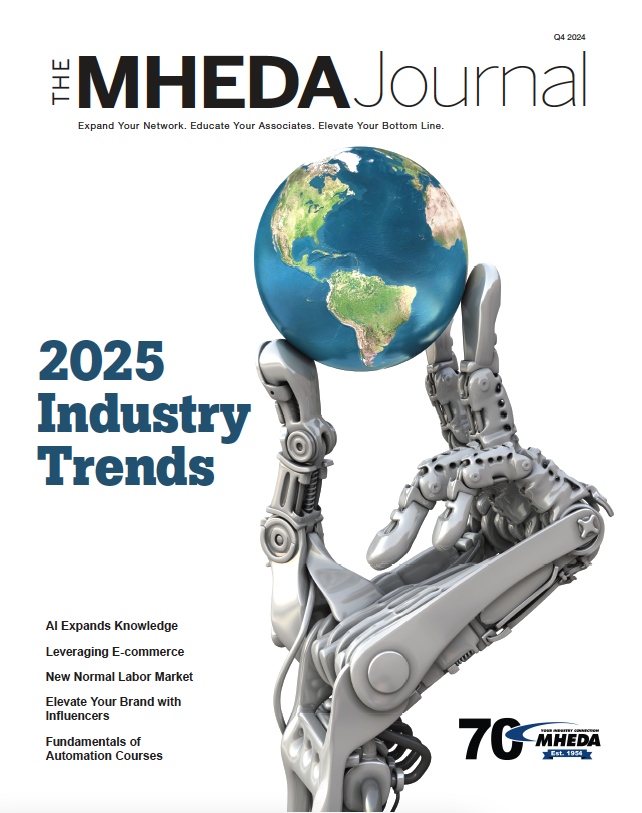Tips for Tackling High Inflation
January 18, 2023
Oracle NetSuite White Paper Offers 8 Strategies for Dealing with Rising Costs
By Nick Fortuna
 It’s clearly too early to celebrate, but there have been signs that inflation is easing gradually, giving rise to cautious optimism in the business community. That includes distributors and manufacturers of material-handling equipment, which have seen their biggest costs, including labor and raw materials, rise sharply in recent years.
It’s clearly too early to celebrate, but there have been signs that inflation is easing gradually, giving rise to cautious optimism in the business community. That includes distributors and manufacturers of material-handling equipment, which have seen their biggest costs, including labor and raw materials, rise sharply in recent years.
In July, the inflation rate dipped to 8.5% from 9.1%, and the consumer price index was flat after rising for 25 consecutive Tips for Tackling High Inflation Oracle NetSuite White Paper Offers 8 Strategies for Dealing with Rising Costs months, according to the Labor Department. Also in July, U.S. freight rates decreased 2% month over month as fuel prices continued their steady decline, signaling that the U.S. market may have reached peak freight rates, according to a report from Cass Information Systems.
Still, it likely will take some time for inflation to decrease to the Federal Reserve’s target rate of 2%, and for many in the material-handling industry, relief can’t come soon enough.
“Inflation has impacted every facet of the automation and materials-handling world,” said Ed Romaine, Vice President of Marketing and Business Development for Conveyco, which specializes in order- fulfillment and warehouse-automation systems.
Prices for commodities appear to have stabilized recently, but as they climbed ever higher, manufacturers of material handling equipment were providing quotes that were good for only seven days, Romaine said. Companies were justifiably to keep your prices competitive. The element of risk is simply much higher with an upward-trending inflation rate.”
With high inflation lingering, the business software company Oracle NetSuite published a white paper outlining eight “expert-backed strategies for proactive” chief financial officers. In the paper, researchers say they expect cost increases stemming from supply-chain disruptions to persist through year’s end, while higher labor costs are likely to stick around permanently.
Here’s a summary of their eight recommendations:
1) Create agile financial plans. When performing financial planning and analysis, executives should consider any number of variables and their company’s possible responses to changing market dynamics. That includes sudden changes to economic conditions, monetary policy and the supply chain.
Chelsie Kugler, Vice President of Business Development at CFOshare, said a good business plan allows a company to react quickly to changing conditions. In the report, she said executives should use their financial forecast to run “what-if” scenarios related to inflation, such as a 15% increase in wages for key positions, a doubling in prices for raw materials and supply-chain disruptions causing revenue delays and inventory buildups of at least 25%.
For each scenario, executives should ask themselves how cash flow would be affected, what actions could be taken to blunt the effects, what preventive measures could be taken now, and what leading indicators could be used to predict these scenarios. Businesses that plan for a range of potential situations “can proactively drive toward desired outcomes,” according to the report.
2) Diversify supply chains, even if doing so costs more. Streamlined, cost effective supply chains are more vulnerable to economic shocks, according to Dr. Tuan Nguyen, the U.S. economist for RSM US LLP, an audit, tax and consulting firm.
In the report, he said executives should consider having multiple vendors for key materials and services, including domestic sources that will be available in the event of global disruptions. Additionally, companies should consider stockpiling materials that are vital to their business, reversing the recent trend toward just-in-time delivery and low inventories, he said. This strategy is especially important when key components or materials are hypersensitive to inflation, Nguyen said.
Switching to domestic vendors or obtaining materials from multiple sellers likely will increase costs, so companies should explore the possibility of passing those costs on to customers, he added. Another approach is to gain more control over your supply chain by partnering with vendors, often through mergers or acquisitions, and by working to strengthen relationships with key suppliers, according to the report.
3) Engage in targeted cost-cutting. Broad, across-the-board cuts could impede a company’s growth and harm its brand, according to the report. Instead, companies should consider eliminating initiatives that aren’t a core function of their business or are under performing.
By reducing those costs, businesses can continue to invest in areas that are profitable and offer the most potential for growth. Personnel, equipment, tools and processes that give a business a clear advantage over its rivals should be preserved, even during difficult times, according to the report.
To prioritize the right investments, executives should consider “adopting a version of zero-based budgeting,” in which expenses are justified individually and supervisors must show how that spending is aligned with the business’s overall strategy, the report said. This approach carries the risk that executives will become “bogged down in the sheer amount of financial data,” however, especially if they’re still relying upon manually updated spreadsheets, according to the report.
4) Consider the four C’s of pricing. Amid high inflation, companies should consider raising their prices, but by doing so, they risk losing market share to competitors. To ensure that prices are set appropriately, executives should evaluate the four C’s – customers, costs, competitors and cash, according to the report.
Companies should determine how important pricing is in their customers’ purchasing decisions. If a brand is known for its high-quality goods and services, perhaps customers would be willing to pay more. However, if getting the best price is customers’ top priority, then holding the line on prices likely is the wise business decision, the report said.
Executives should track how much they’re paying for materials, labor and other expenses, recognizing that if those figures rise substantially, price increases may be inevitable. If your competitors have raised their prices, you may want to follow suit to preserve your margins. Alternatively, if your business’s cash flow remains healthy, you could keep prices steady in a bid to increase market share, according to the report.
To lessen the perceived impact of price increases on customers, companies should consider bundling or unbundling products, allowing for payment in installments, adding or removing premium features or implementing different pricing models for different product varieties, the report noted.
5) Pare down your portfolio of products and services. SKU proliferation has been a well-documented retail trend, but when times get tough, companies might want to eliminate low-margin product offerings and focus on “high-margin core products with the most consumer demand,” according to the report.
Niche items and newer product offerings that may or may not catch on should be the first to go. Eliminating less-popular products from store shelves might even create a better shopping experience for customers, the report noted.
6) Build up your inventory if you expect prices to rise further. Imagine the competitive advantage a car company would have enjoyed had it stockpiled semiconductor chips ahead of the pandemic. Building up inventories of materials that are essential to your business is a smart use of cash, especially when inflation is high and prices can reasonably be expected to increase more, according to the report.
Although warehousing costs have increased, businesses that stockpile key materials will be better able to serve customers during supply-chain disruptions, allowing them to maintain or increase their market share. Having robust supplies on hand also may allow companies to avoid increasing prices for their products, even as their competitors have no other choice, the report said.
7) Consider hedging to reduce risks. Trading futures contracts on a commodities exchange is a popular hedging strategy during periods of high inflation, according to the report. A futures contract is an agreement to buy or sell a particular asset at a set price and at a specific time.
This hedging tactic offers some cost predictability, enabling companies to plan more effectively and to protect themselves from future price spikes.
The report cites the example of a chain of cafés facing rising prices, so it agrees to buy a thousand pounds of coffee beans at $2 a pound. Importantly, the company won’t actually be taking delivery of coffee from a supplier at that agreed-upon price. Instead, it will be buying a futures contract through an exchange or over-the-counter trading desk, the report noted.
If prices go up, then the business will make money on its futures contract, offsetting the higher cost the company must pay to buy coffee from its suppliers. If prices go down, then the company will lose money on its contract, but it still will be paying less to get coffee from its suppliers.
8) Cut costs through automation. Investing in automated technology can reduce the amount of manpower needed for operations, which greatly lowers labor costs. Automation also can eliminate the need for employees to perform tedious, repetitive tasks, which improves their work experience and promotes worker retention.
Automated software and equipment often can handle simple tasks faster than humans, and without taking breaks, boosting productivity, according to the report.
“Increased productivity is always the best and most sustainable tool to counter inflation,” Nguyen said.
This is a summary of “8 Actions to Manage Inflation: Expert-Backed Strategies for Proactive CFOs.” The full article can be found at https://www.netsuite.com/portal/resource/articles/financial-management/deal-with-inflation.shtml






